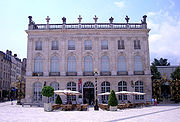
Museum of Fine Arts of Nancy
Encyclopedia

The Museum of Fine Arts of Nancy (in French
French language
French is a Romance language spoken as a first language in France, the Romandy region in Switzerland, Wallonia and Brussels in Belgium, Monaco, the regions of Quebec and Acadia in Canada, and by various communities elsewhere. Second-language speakers of French are distributed throughout many parts...
: Musée des Beaux-Arts de Nancy) is one of the oldest museums in France
France
The French Republic , The French Republic , The French Republic , (commonly known as France , is a unitary semi-presidential republic in Western Europe with several overseas territories and islands located on other continents and in the Indian, Pacific, and Atlantic oceans. Metropolitan France...
. It was created in 1793. It is hosted in one of the four large pavilions on the Place Stanislas
Place Stanislas
The Place Stanislas, known colloquially as the place Stan, is a large pedestrianized square in Nancy, Lorraine, France. Since 1983, the architectural ensemble comprising the Place Stanislas and the extension of its axis, the Place de la Carrière and Place d'Alliance, has been on the list of UNESCO...
created in 1755 by Stanislas Leszczyński, duke of Lorraine.
Some of the painters whose work is featured in the collections are Perugino, Tintoretto
Tintoretto
Tintoretto , real name Jacopo Comin, was a Venetian painter and a notable exponent of the Renaissance school. For his phenomenal energy in painting he was termed Il Furioso...
, Jan Brueghel the Younger
Jan Brueghel the Younger
Jan Brueghel the Younger was a Flemish Baroque painter, and the son of Jan Brueghel the Elder.He was trained by his father and spent his career producing works in a similar style. Along with his brother Ambrosius, he produced landscapes, allegorical scenes and other works of meticulous detail. ...
, Caravaggio
Caravaggio
Michelangelo Merisi da Caravaggio was an Italian artist active in Rome, Naples, Malta, and Sicily between 1593 and 1610. His paintings, which combine a realistic observation of the human state, both physical and emotional, with a dramatic use of lighting, had a formative influence on the Baroque...
, Georges de La Tour
Georges de La Tour
Georges de La Tour was a French Baroque painter, who spent most of his working life in the Duchy of Lorraine, which was temporarily absorbed into France between 1641 and 1648...
, Charles Le Brun
Charles Le Brun
Charles Le Brun , a French painter and art theorist, became the all-powerful, peerless master of 17th-century French art.-Biography:-Early life and training:...
, Ribera
Ribera
Ribera is a Spanish word that translates into "the basin of a river", and may refer to:Locations* Ribera, Agrigento, a comune in the province of Agrigento, Sicily, Italy...
, Rubens
Rubens
Rubens is often used to refer to Peter Paul Rubens , the Flemish artist.Rubens may also refer to:- People :Family name* Paul Rubens Rubens is often used to refer to Peter Paul Rubens (1577-1640), the Flemish artist.Rubens may also refer to:- People :Family name* Paul Rubens (composer) Rubens is...
, Claude Gellée (known as Le Lorrain and Claude), Luca Giordano
Luca Giordano
Luca Giordano was an Italian late Baroque painter and printmaker in etching. Fluent and decorative, he worked successfully in Naples and Rome, Florence and Venice, before spending a decade in Spain....
, François Boucher
François Boucher
François Boucher was a French painter, a proponent of Rococo taste, known for his idyllic and voluptuous paintings on classical themes, decorative allegories representing the arts or pastoral occupations, intended as a sort of two-dimensional furniture...
, Eugène Delacroix
Eugène Delacroix
Ferdinand Victor Eugène Delacroix was a French Romantic artist regarded from the outset of his career as the leader of the French Romantic school...
, Edouard Manet
Édouard Manet
Édouard Manet was a French painter. One of the first 19th-century artists to approach modern-life subjects, he was a pivotal figure in the transition from Realism to Impressionism....
, Claude Monet
Claude Monet
Claude Monet was a founder of French impressionist painting, and the most consistent and prolific practitioner of the movement's philosophy of expressing one's perceptions before nature, especially as applied to plein-air landscape painting. . Retrieved 6 January 2007...
, Paul Signac
Paul Signac
Paul Signac was a French neo-impressionist painter who, working with Georges Seurat, helped develop the pointillist style.-Biography:Paul Victor Jules Signac was born in Paris on 11 November 1863...
, Modigliani
Amedeo Modigliani
Amedeo Clemente Modigliani was an Italian painter and sculptor who worked mainly in France. Primarily a figurative artist, he became known for paintings and sculptures in a modern style characterized by mask-like faces and elongation of form...
, Picasso, Raoul Dufy
Raoul Dufy
Raoul Dufy[p] was a French Fauvist painter. He developed a colorful, decorative style that became fashionable for designs of ceramics and textiles, as well as decorative schemes for public buildings. He is noted for scenes of open-air social events...
...
The museum is open very day from 10 a.m. to 6 p.m. except on Tuesdays, and is closed 1st January, 1st May, 14th July, 1st November and 25th December. It is accessible to disabled persons.
See also
- Presentation of the Museum
- Musée de l'École de NancyMusée de l'École de NancyThe Musée de l'École de Nancy is a museum devoted to the École de Nancy, an Art Nouveau movement founded in 1901 by Émile Gallé, Victor Prouvé, Louis Majorelle, Antonin Daum and Eugène Vallin in the city of Nancy in Lorraine...

